What Is Weirs | Types of Weirs | Advantages & Disadvantages of Weirs | Operation & Limitations For Weir | Limitations of Weirs | Location of Weirs
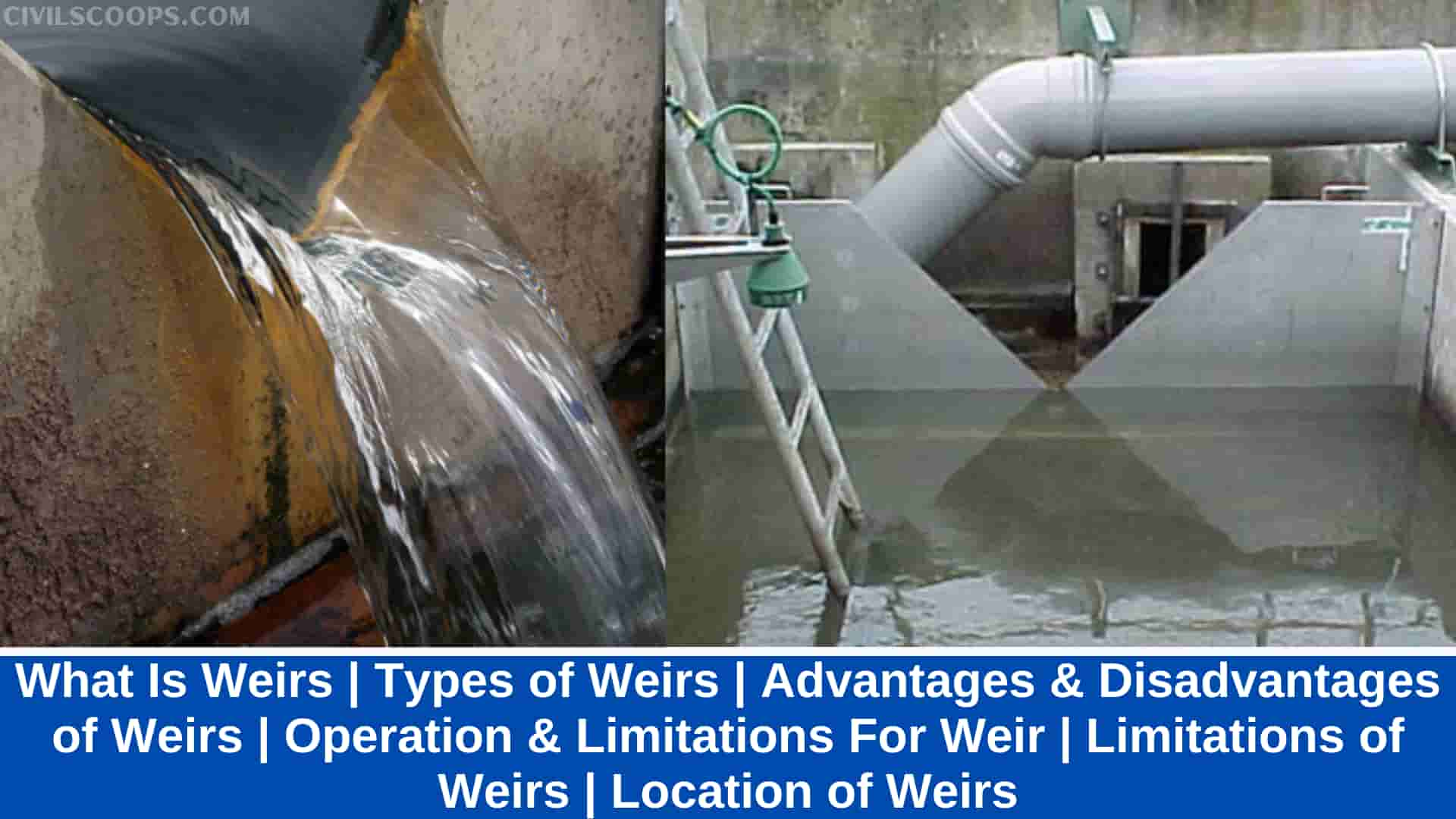
Table of Contents
What Is Weirs?
Weir is characterised as a barrier through which water flows into an open channel. The edge or surface on which the water runs is called the crest. The overflowing water layer is the water table.
If the nappe is discharged into the air, the weir gets a free discharge. If the discharge is partially under water, the weir is either buried or drowned.
A weir is a concrete or masonry bridge that is built over an open canal (such as a river) to alter the water flow characteristics. Weirs are built as an obstacle to the passage of water. This are widely used to calculate the volumetric flow of water, avoid floods, and make rivers navigable.
Types of Weirs
Here, the different types of weirs are as follows.
- Types of Weirs depending on the Opening Shape.
- Rectangular weir.
- Triangular weir.
- Trapezoidal weir.
- Types of Weirs dependent on the Crest form.
- Sharp- weir crested.
- Broad crested weir.
- Narrow crested weir.
- Weir Ogee-shaped.
- Types of weirs depending on the effect of the sides on the nappe.
- Weir with the end of contraction (contracted weir).
- Weir without the end of contraction (suppressed weir).
Let us know more detailed knowledge about different types of weir.
1. Classification Based on Shape of Opening
Here, three different types of weirs based on shape of opening are discussed in detail.
1.1. Rectangular Weir
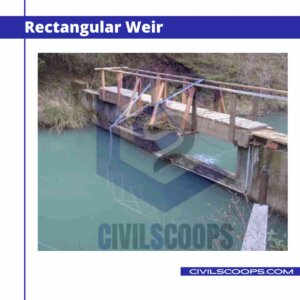
It’s the standard form of a weir. The upper edge of the weir can be sharply crested or narrowly crested. It is normally ideal for wider flow channels.
Rectangular weir derives its name from the form of the notch. The discharge through such a weir or notch is connected directly to the depth of water (H) and H is regarded as the head.
One such head is influenced by the state of the crest, the contraction, the strength of the incoming stream as well as the elevation of the water surface downstream of the weir. Rectangular wires can be suppressed, partly contracted or completely contracted.
Flow Over Rectangular Weir
In order to find a flow over a rectangular weir, assume the elementary horizontal strip of water thickness dh and length L at depth h again from water level.
Strip area = L x dh
Theoretical speed of water = √2gh
As a result, discharge by strip
dQ = Cd x area of strip x √2gh
dQ = Cd x L x dh x √2gh
Where,
- Cd = Discharge Coefficient
Through integrating of above formula with the limitations 0 to H, we could achieve the complete discharge Q.
Q = ∫OH Cd x L x dh x √2gh
In the end, discharge over the weir
Q = 2/3 x Cd x L x √2g x H 3/2
1.2. Triangular Weir
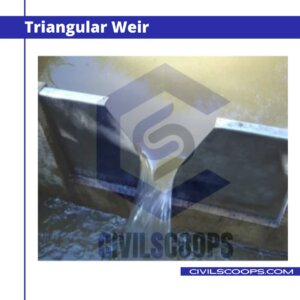
The form of the weir is basically a reverse triangle like V, so it’s often called V-notch weir. This kind of wire is well suited for calculating discharge over small flows with greater precision.
Flow Through Triangular Weir
In this considering the elementary horizontal strip of water width, i.e. distance h from the surface of the water.
Tan [θ/2] = [(AC)/(H-h)]
Therefore,
- Area of Strip = dh x Width of strip AB
- Area of Strip = dh x 2AC
Area of Strip = 2 (H-h) x Tan θ/2 x dh
Theoretical velocity of water = √2gh
Therefore,
Discharge through strip (dQ) = Cd x area of strip x velocity of water
dQ = Cd x Area of strip x √2gh
dQ = Cd x (2 (H-h) x Tan θ/2 x dh) x √2gh
Through integrating of above formula with the limitations 0 to H, we could achieve the complete discharge Q.
Therefore,
Q = ∫OH Cd x (2 (H-h) x Tan θ/2 x dh) x √2gh
In conclusion, we develop
Q = (8/15) x Cd x Tan θ/2 x √2g x H 5/2
1.3. Trapezoidal Weir
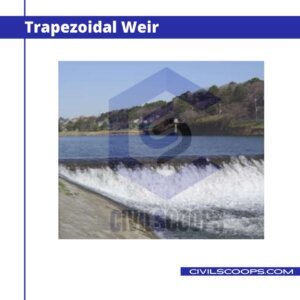
Trapezoidal weir is often named Cippoletti weir. That’s also trapezoidal in form and alters the rectangular weir with such a slightly greater potential for about the same crest weight.
The sides are bent outward with a slope of 1:4.
Flow Through Trapezoidal Weir
In cippoletti, all sides have an even slope. So, we will segment the trapezoid into rectangles and triangles.
So, Well, Full discharge over a trapezoidal weir
Q = discharge over rectangular weir + discharge through triangular weir
Q = [(2/3)Cd x L x √2g x H 3/2 ] + [ (8/15) x Cd x Tan θ/2 x √2g x H 5/2]
2. Classification According to Shape of Crest
Here, three different types of weirs based on the shape of crest are discussed in detail.
2.1. Sharp Crested Weir

The peak of the weir is so sharp that perhaps the water is visible from the crest. The weir plate is beveled edge at the edges of the crest to achieve the required thickness. And the plate should be made of smooth brass, free from corrosion and nicks.
Flow over a sharp-edged weir is similar to a rectangular weir. They are commonly used to assess the water on the farm. They are usually of three forms depending on the form of the notch.
These are
- Rectangular Weir
- Cipoletti Weir or Trapezoidal Weir
- V Notch Weirs or Triangular Weir
2.2. Broad Crested Weir
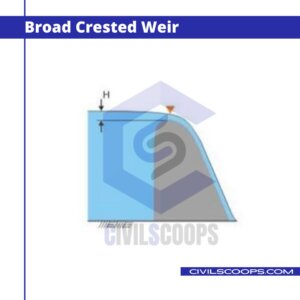
They are formed only in a rectangular form and are ideal for larger flows. Head damage would be minimal in the event of a large crested weir.
A weir which has a horizontal or almost horizontal crest sufficiently long in the direction of the flow such that the nappe is stabilised and the hydrostatic pressures are completely formed for at least a short distance.
2.3. Narrow Crested Weir
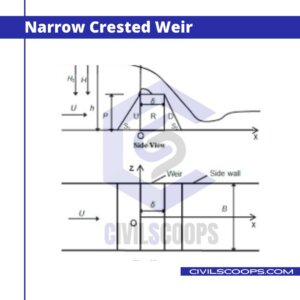
It is identical to a rectangular weir with a narrow rounded crest at the end. The discharge over shallow crested weirs is close to the discharge over rectangular weirs.
2.4. Weir Ogee Shaped
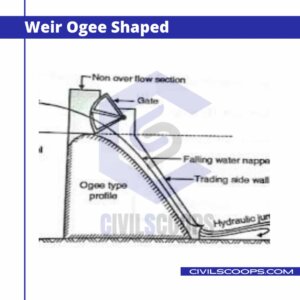
Normally, ogee-shaped weirs are established for the spillway of the storage dam. The crest of the ogee weir rises slightly and sinks into a parabolic shape.
Flow over ogee weir is almost close to flow over rectangular weirs.
3. Classification Based on End Contractions
Here, three different types of weirs based on end construction are discussed in detail.
3.1. Contracted Weir
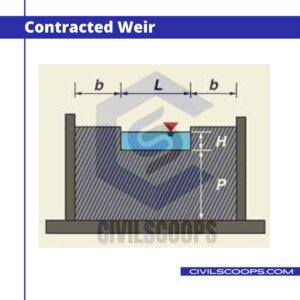
The crest is cut in the shape of a notch and is similar to a rectangular weir. Head loss is going to occur in this type. The sides and the crest of the weir are far from the sides and the bottom of the approach channel. The nappe is fully contracted laterally at the ends and vertically at the crest of the weir. It was often considered an “unsuppressed” weir.
3.2. Suppressed Weir

The crest runs all the way through the river so the head loss is marginal. Rectangular wire, the notch or the opening sides of which coincide with the sides of the approach canal, often rectangular, extending unaltered downstream from the weir. This is the horizontal flow contraction that is “suppressed.”
Advantages of Weirs
Here, the pros of weirs are as follows.
- Able to measure a diverse variety of flows correctly.
- Can be compact and adjustable.
- Easy to build Seems to have a more precise discharge rating than flumes and orifices.
Disadvantages of Weir
Here, the cons of weirs are as follows.
- Relatively large head required, especially in free-flow conditions.
- The upstream pool must be kept clear of sediment and kept free of weeds and litter. Otherwise, the accuracy of the calculation
would be impaired.
Operation For Weir
Here, the operation of weirs are as follows.
- Properly designed and mounted wires provide the most precise flow measurement. However, incorrect setting and procedure
can result in significant errors in the calculation of discharge. In order to ensure accurate calculation performance, the following
steps are mandatory for the use of weirs. - The weirs should be set at the bottom of a long pool sufficiently wide and deep with a steady flow at speeds of less than
15cm/sec. - Baffles can be placed in a weir pond to minimise velocity.
- The wall of the weir must be vertical.
- The middle line of the wire should be parallel to the direction of flow.
- The crest of the weir ought to be level such that the water flowing into it would be at the same width at both points around the
crest. - Notch should be a normal form and should have a rigid and straight tip.
- The weir crest is to be above the bottom of the approach channel.
- The crest of the weir should be set high enough to allow the water to fall freely below the weir.
- The depth of the water flow over the rectangular weir should not be less than 5 cm and not more than 2/3 crest distance.
- The scale or gauge used to measure the head should be about four times the approximate head. Zero of magnitude should be
precisely at the same degree as the crest of the weir.
Limitations of Weirs
Here, the limitation of weirs are as follows.
- Weirs are not necessarily optimal for flow measurement. A sufficient head is required to operate some kind of weir.
- They are not correct until the right circumstances are maintained.
- They need a significant loss of head, which is often not possible in flat gradient channels.
- Weirs are not ideal for silt transporting water.
- Weirs are not conveniently paired with a turnout structure.
Location of Weirs
Here, the uses in a different areas of weirs are as follows.
- A weir must be situated in a balanced section of the river, where even the river is unwilling to alter direction.
- The weir needs to be installed high enough to meet the command specifications. During high flooding, the river could overwhelm its banks and reverse its course. The position with firm, well-defined banks must therefore be chosen for the construction of the
weir. - The site must have nice bed requirements, including such rock outcrops, where appropriate.
- Optionally, weirs must be reduced to a minimum.
[su_box title=”FAQ” style=”default” box_color=”#333333″ title_color=”#FFFFFF” radius=”3″ class=”” id=””]
Weir Definition
A weir or low head dam is a barrier across the width of a river that alters the flow characteristics of water and usually results in a change in the height of the river level. They are also used to control the flow of water for outlets of lakes, ponds, and reservoirs.
What is the Purpose of a Weir?
Weirs are fixed barriers across a river or stream that force water to flow over their tops, where the height of the water above the weir can be used to calculate flow.
Concrete Weir
A weir is a concrete or masonry structure which is constructed across the open channel (such as a river) to change its water flow characteristics. Weirs are constructed as an obstruction to flow of water. These are commonly used to measure the volumetric rate of water flow, prevent flooding and make rivers navigable.
Rectangular Weir Equations
Units the suppressed rectangular weir equation becomes Q = 1.84 B H3/2, where Q is the water flow rate in m3/sec, B is the length of the weir (and the channel width) in m, and H is the head over the weir in m.
Weir Structure
A weir is a concrete or masonry structure which is constructed across the open channel (such as a river) to change its water flow characteristics. Weirs are constructed as an obstruction to flow of water. These are commonly used to measure the volumetric rate of water flow, prevent flooding and make rivers navigable.
Weir Flow Equation
The equation recommended by the Bureau of Reclamation in their Water Measurement Manual, for use with a suppressed rectangular weir is: Q = 3.33 B H3/2, where Q is the water flow rate in ft3/sec, B is the length of the weir (and the channel width) in ft, and H is the head over the weir in ft.
Types of Weirs
The common shapes of weirs are, rectangular, triangular, trapezoidal, composite, parabolic and proportional. The sheet of water which springs free from the crest is called the nappe. If the sheet of water springs free as it leaves the crest, the weir is called a sharp crestel weir.
What Is the Main Function of Weir?
A weir is a small barrier built across a stream or river to raise the water level slightly on the upstream side; essentially a small-scale dam. Weirs allow water to pool behind them while allowing water to flow steadily over top of the weir.
Which Is Not a Type of Weir?
Trapezoidal crested weir is not the way of classifying weir based on their shape of crest.
Application of Weirs
Commonly, weirs are used to prevent flooding, measure water discharge, and help render rivers more navigable by boat. In some locations, the terms dam and weir are synonymous, but normally there is a clear distinction made between the structures.
What Are Advantages of Weirs?
Weirs can be built to measure water flow rate, to alter the flow of rivers, or to prevent flooding. Additionally, small-size weirs can be used in large hydropower developments as a way to mitigate potential harm that may come about as a result of dam development.
What Are the Limitations of Weirs?
Here, the disadvantages of weirs are as follows.
- Spacious Upstream Weir Pool Required.
- Cold Weather Can Compromise Readings.
- Discharge Must Be Free-Spilling.
- Weir Maintenance Is Extensive.
- Weirs and Flumes From Tracom.
Broad-Crested Weir
A broad-crested weir is an overflow structure with a horizontal crest above which the deviation from a hydrostatic pressure distribution because of centripetal acce- leration may be neglected. In other words, the streamlines are practically straight and parallel.
Narrow Crested Weir
It is similar to a rectangular weir with a narrow-shaped crest at the top. The discharge over the narrow crested weir is similar to the discharge over the rectangular weir. If 2b is less than H, the weir is called a narrow-crested weir.
Broad-Crested Weir Formula
If a broad crested weir has the minimum height needed for critical flow, then the simple equation, Q = 1.6 L H3/2, can be used for flow rate calculations over that broad crested weir.
What Does a Weir Do?
A weir is a small barrier built across a stream or river to raise the water level slightly on the upstream side; essentially a small-scale dam. Weirs allow water to pool behind them, while allowing water to flow steadily over top of the weir.
Types of Weirs
[/su_box]
[su_note note_color=”#F2F2F2 ” text_color=”#333333″ radius=”3″ class=”” id=””]
Like this post? Share it with your friends!
Suggested Read –
- What Is Lintel? | Function of Lintel | Types of Lintel
- What Is Grouting | Type of Grouting | Experiment of Grouting | Characteristics of Grouting | Types of Grout for Ceramic Tile | Advantage of Grouting | Disadvantage of Grouting
- What Is Grade of Concrete | Concrete Mix Ratio | Type of Concrete Mix | Different Types of Concrete Grade with Concrete Mix Ratio and Compressive Strength | Uses of Different Grades of Concrete
- What Is Hidden Beam | Why Is It Used | Where Is It Used in Buildings | How to Design a Hidden Beam | Purpose of Hidden Beam | Advantages of Hidden Beam | Disadvantages of Hidden Beam
- What Is Super Elevation? | Superelevation Definition | Purpose of Providing Superelevation in Roads | Calculation of Superelevation in Roads | Minimum and Maximum Superelevation in Roads | Method of Providing Superelevation to the Roads
[/su_note]
Originally posted 2022-08-04 14:22:03.
